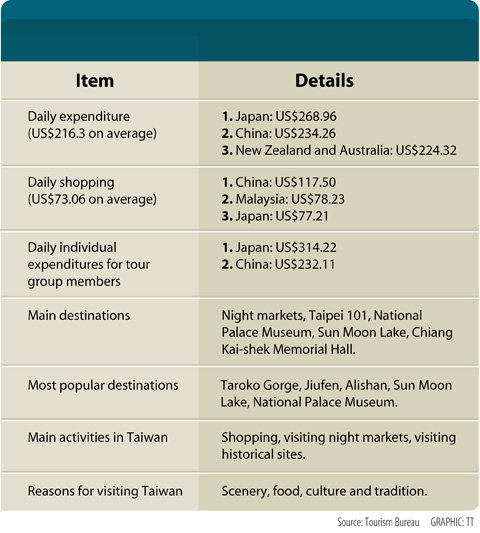China’s second-largest direct marketing company, Perfect (China) Commodity Co, is in the process of sending 130 tour groups, consisting of a total of 5,200 people, to Taiwan over a five day period.
While this may seem like a lot of people, statistics from the Tourism Bureau paint a different picture of Chinese tourists.
On Wednesday, the bureau released a report on the spending habits of tourists who visited Taiwan last year.

The report showed that Chinese tourists spent more on shopping here than Japanese tourists, spending an average of US$117 per day, approximately equivalent to NT$3,800, which was 50 percent more than tourists from Malaysia, who were listed as spending the second most on shopping.
However, the report showed that Japanese tourists spent the most on accommodation and food, spending an average of NT$10,000 per day in these areas, which was 35 percent more than tourists from China.
According to the report, one million Japanese tourists visited Taiwan last year, which was a drop off of approximately 8 percent from 2008.
Japanese tourists still contributed the most foreign income to Taiwan’s economy, accounting for a total of NT$60 billion, the report showed.
Chinese tourists were listed as second, with 970,000 visiting Taiwan, almost double the number in 2008, bringing in approximately NT$51 billion.
The bureau’s statistics showed that after the decision two years ago to allow Chinese tourists to travel to Taiwan, the increase in Chinese tourists has corresponded to a drop in the overall amount of money spent by tourists in Taiwan.
The bureau said that with the increase in the number of Chinese tourists to Taiwan, the influence of their expenditures on Taiwan’s economy has increased.
The Chinese tourists who initially visited Taiwan were those with high incomes, but now lower income Chinese are coming and this has naturally led to a decrease in the overall spend per tourist.
The report showed 4.39 million people visited Taiwan last year and spending a total of US$6.8 billion (NT$219 billion), an increase of approximately 14 percent and the highest amount Taiwan has ever made from tourism.
The report also showed that last year, tourists who came to Taiwan for business, in tour groups and those who visited individually spent an average of US$216, approximately NT$7,000 per day, on accommodation, food, transport and shopping.
Meanwhile, the first tour group from Perfect (China) Commodity Co, made up of 440 people, arrived at Kaohsiung Siaogang Airport on Thursday and proceeded to travel by bus to Kenting and elsewhere.
However, the nine-day trip to Taiwan does not include Kaohsiung and Tainan. When asked, tour members said they didn’t know whether political factors were a factor.

Trips for more than 100,000 international and domestic air travelers could be disrupted as China launches a military exercise around Taiwan today, Taiwan’s Civil Aviation Administration (CAA) said yesterday. The exercise could affect nearly 900 flights scheduled to enter the Taipei Flight Information Region (FIR) during the exercise window, it added. A notice issued by the Chinese Civil Aviation Administration showed there would be seven temporary zones around the Taiwan Strait which would be used for live-fire exercises, lasting from 8am to 6pm today. All aircraft are prohibited from entering during exercise, it says. Taipei FIR has 14 international air routes and

Taiwan lacks effective and cost-efficient armaments to intercept rockets, making the planned “T-Dome” interception system necessary, two experts said on Tuesday. The concerns were raised after China’s military fired two waves of rockets during live-fire drills around Taiwan on Tuesday, part of two-day exercises code-named “Justice Mission 2025.” The first wave involved 17 rockets launched at 9am from Pingtan in China’s Fujian Province, according to Lieutenant General Hsieh Jih-sheng (謝日升) of the Office of the Deputy Chief of the General Staff for Intelligence at the Ministry of National Defense. Those rockets landed 70 nautical miles (129.6km) northeast of Keelung without flying over Taiwan,

The Ministry of National Defense (MND) today released images of the military tracking China’s People's Liberation Army (PLA) movements during the latest round of Chinese drills around Taiwan. The PLA began "Justice Mission 2025" drills today, carrying out live-fire drills, simulated strikes on land and maritime targets, and exercises to blockade the nation's main ports. The exercises are to continue tomorrow, with the PLA announcing sea and air space restrictions for five zones around Taiwan for 10 hours starting from 8:30am. The ministry today released images showing a Chinese J-16 fighter jet tracked by a F-16V Block 20 jet and the

City buses in Taipei and New Taipei City, as well as the Taipei MRT, would on Saturday begin accepting QR code payments from five electronic payment providers, the Taipei Department of Transportation said yesterday. The new option would allow passengers to use the “transportation QR code” feature from EasyWallet, iPass Money, iCash Pay, Jkopay or PXPay Plus. Passengers should open their preferred electronic payment app, select the “transportation code” — not the regular payment code — unlock it, and scan the code at ticket readers or gates, General Planning Division Director-General Liu Kuo-chu (劉國著) said. People should move through the